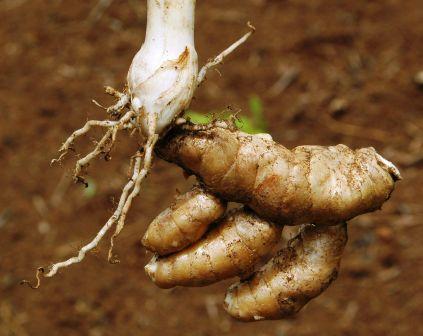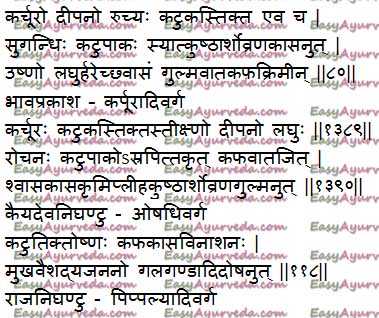Kachur – Curcuma zedoaria: Uses, Dose, Side Effects, Research
By Dr Renita D’Souza Kachur is an Ayurvedic herb used in the treatment of fever, cough, asthma, piles, skin diseases, worm infestation etc. Commonly known as white turmeric.
Botanical Name – Curcuma zedoaria Family – Zingiberaceae (Ardraka Kula)
Table of Contents
Vernacular names
Names in different languages
Sanskrit Name – Karchura
Hindi Name – Karchur
Kannada Name – Kachora
Tamil Name – Kichilik, Kizangu, Poolangizhangu
Telugu Name – Kachoramu
Bengali Name – Kachura, Shori, Ekangi, Shati
Marathi Name – Kachora
Gujarati Name – Kachuro, Shat kachuro
Malayalam Name – Kachchurikizhanna
Unani Name – Narkachoor, Zaranbad
English Name – Zedoary, White turmeric
Home remedies
Traditional Uses of Kachur
- Hoarseness of voice, bad breath, cough its rhizomes are chewed or it can also be used as tooth powder.
- In wounds and sprains its paste is applied.
- Decoction prepared using kachur rhizomes, cinnamon, long pepper is taken along with honey in conditions like fever, cough and rhinitis.
- In ascites its leaf juice is used.
- In haemorrhoids and diarrhoea its rhizomes are used as vegetable.
- In seizures its paste is applied over head and body.
- Fresh juice of rhizome is used in intestinal worm infestation.

Qualities, indications
Medicinal Qualities of Kachoora
Rasa (taste) – Katu (pungent ), Tiktha (bitter)
Vipaka (post digestive effect) – Katu (pungent)
Virya (potency) – Ushna (hot)
Guna (qualities) – Laghu (light to digest), Teekshna (penetrating), Sughandhi (odoriferous)
Karma (action) – Deepana – kindles digestive fire
Ruchya – improves taste perception
Indications of Kachura
Kushta – skin diseases
Arshas -hemorrhoids
Vrana – heals wounds
Kasa – cough
Shvasa – asthma
Gulma – abdominal tumours
Krimi – intestinal worm infestation
Pliha – enlargement of spleen
Mukhavaishadya – cleanses mouth, removes bad breath Kapha related diseases like in congestion it reduces phlegm, it clears hoarseness of voice etc
Effect of Kachur on Tridoshas Balances Vata and Kapha Dosha
Interaction with medicines, supplements
Can this be used while taking Homeopathic medicine?
Yes. This product does not react with homeopathic medicine.
Can this medicine be continued while taking supplements like multivitamin tablets, Omega 3 fatty acids etc?
Yes. Generally, this product goes well with most dietary supplements. However, if you are taking more than one product per day, please consult your doctor for an opinion.
With western
medicines
Seek your
doctor’s advice if you are taking this product along with other western
(allopathic / modern) medicines. Some Ayurvedic herbs can interact with modern
medicine.
If both Ayurvedic and allopathic medicines are advised together, then it is
best to take Allopathic medicine first, wait for 30 minutes and then take the
Ayurvedic medicine.
Part used, dose, morphology
Part Used Rhizome
Dosage Root powder – 1 – 3 grams Decoction – 15 – 30 ml
Morphology of Curcuma zedoaria
Its a perennial aromatic herb bearing yellowish orange flowers. Leaves are long, green growing up to 1 meter in height. Rhizomes are aromatic, pale yellow in colour inside when cut.
Pharmacology, Side effects, Sanskrit verse
Pharmacological properties of Curcuma zedoaria Anti fungal, , Anti-amoebic, Analgesic, Anti-allergic, Anti-ulcer, Anti inflammatory etc
Side Effects of Kachoora
Due to its hot and penetrating quality it is best to avoid excess burning sensation, heavy menstrual bleeding, bleeding disorders and other high pitta conditions. Best to avoid its usage in pregnancy and lactation.

Distribution, controversy
Distribution Found in India such as in Eastern Himalaya and Shimla; Sri Lanka, Bangladesh and is cultivated in Japan, Tailand, China and Thailand.
Controversies regarding identification of Kacchura:
Kachur is used as a substitute of shati – Hedychium spicatum hence the synonym shati is used for kachur. In ancient text books only shati was mentioned and kachur was mentioned in later text books because of less availability of shati, it was mentioned as a substitute.
Medicines
Ayurvedic medicines with Kachur as an Ingredient
Kachuadi Churnam – In Ayurvedic medicine used to apply externally to relieve headache, burning sensation, dizziness, etc.
Panchagandha Churnam – It is the herbal powder used externally in conditions like giddiness, headache, insomnia, delusion, insanity etc.
Sutshekhar Ras – Ayurvedic tablet or powder form medicine used in dyspepsia, gastritis, vomiting, abdominal colic, cough, cold, diarrhea, dysentery, bloating and indigestion.
Suvarna sutashekara Rasa – Used in gastritis, urticaria, vomiting, nausea etc.
Sri Sri Body Oil – It is used externally to improve complexion and removes skin dryness.
Vilvampachottyadi tailam – Used in head related diseases. Its application over the head comforts the head and eyes, preventing cold.
Ardraka Khandavaleha – It is a Ayurvedic medicine in herbal jam form used in allergic skin diseases, dermatitis, chronic bronchitis, asthma, emaciation, anorexia, bloating, edema, inflammation, itching.
Bangshil Tablet – Used in urinary tract disorders such as burning micturition, cystitis, urethritis, prostatitis etc.
Cystone Syrup – Used in urinary calculi and urinary tract infections. It also has diuretic action.
Categorization, Chemistry
Scientific Classification of Curcuma zedoaria
Kingdom: Plantae
Class: Liliopsida – Monocotyledons
Order: Zingiberales
Family: Zingiberaceae
Genus: Curcuma
Species: Curcuma zedoaria
Classical categorisation of Kachura
Bhavaprakasha – Karpuradi Varga
Raja Nighantu – Pippalyadi Varga
Dhanvantari Nighantu – Chandanadi Varga
Kaiyadeva Nighantu – Aushadi Varga
Chemical constituents of Curcuma zeodaria:
Curcuma zedoaria contains essential oils:, starch, curcumin, gums,etc.
Research
Research Points
1. Research conducted on chemical, pharmacological and ethnomedicinal properties of Curcuma zedoaria have showed its significant effect in treating diarrhoea, cancer, dyspepsia, ulcer, flatulence etc
2. Anti-diarrhoeal activity of Curcuma zedoaria rhizome – A research done for evaluating the anti diarrhoel activity of Curcuma zedoaria rhizome have showed that Curcuma zedoaria extract dose-dependently reduced the severity and frequency of diarrhoea in mice compared with the standard antimotility drug loperamide. Thus this study justify its traditional use to treat diarrhoea.
3. Anti-cancer activity in metastatic Ovarian Cancer – Research done on cytotoxic activity of various extracts of Curcuma zedoaria have proved its significant cytotoxic activity on metastatic ovarian cancer cells and HUVEC cells.
4. Antimicrobial activity – Research conducted on antimicrobial activity of the essential oil of Curcuma zedoaria (Berg.) Rosc reveals its potential antimicrobial activity against some of the Gram- positive and negative pathogenic microorganisms.
5. Anti-inflammatory activity – A research study conducted on anti inflammatory activity of Curcuma zedoaria Rosc root extracts have evaluated the significant anti inflammatory effect of petroleum ether 200 and chloroform 400 mg/kg extracts of Curcuma zedoaria.
6. Analgesic activity – A study done on phytochemical analysis and analgesic activity of Curcuma zedoaria rhizomes have confirmed its significant use in relieving pain.
7. Anti fungal activity – Study of Anti-fungal efficiency of Curcuma zedoaria (christm.) Roscoe against Fusarium oxysporum, the result have showed maximum inhibition by the extract of Curcuma zedoaria (Christm.) Roscoe.
8. Anti cancer activity – A study proved that the essential oil of Curcuma zedoaria have efficient cytotoxic effects on non-small cell lung carcinoma cells and causes cell apoptosis.
Sanskrit Synonyms of Kachoora Kachura Vedamukya Dravida Kalpaka, Shati Gandamula – rhizomes are aromatic
Click to Consult Dr Renita D’Souza
Sthanika karma (Systemic Acton)
Externally – Reduce pain and inflammation. External application of its paste is indicated in joint pain, skin disorders, etc.
Internally
Nervous system – Pacify vata dosha, improve intellect, Indicated in diseases of vata origin
Digestive system – Digestive, Carminative, Anthelmintic, Mild purgative. Facilitate proper movement of vata dosha. Stimulates liver and is indicated in abdominal cramp, bloating, loss of appetite, Constipation, Hemorrhoids etc.
Circulatory System – In edema, its leaf juice can be given. Stimulate heart.
Respiratory System – Pacify kapha dosha. Indicated in kasa(Cough), hiccough and in breathing difficulties,
Excretory system – Juice of raw rhizome is indicated in dysuria and in urinary tract infection.
Reproductive System – Its fruit is Aphrodisiac and root causes uterine contraction. Indicated in Amenorrhea and in Dysmenorrhea.
Skin – Induce in skin disorders (Kushta)
Indicated in fever











2 comments
VS Viswanaath
Dear Dr. thanks for the great article as always. 2 points here.
1. Tamil name is : Poolangizhangu (pls add to the list of already existing names)
2. List of ayurvedha medicines containing this Kachur – you missed our Kachoradhi Choornam which is an important product for sleep and so many other disorders. Kindly make suitable amendments.
Keep the great work going Dr.
Dr J V Hebbar MD(Ayu)Author
Namaste! Many thanks for your kind support. Both the information are added.